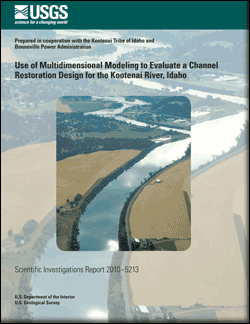Scientific Investigations Report 2010–5213

AbstractRiver channel construction projects aimed at restoring or improving degraded waterways have become common but have been variously successful. In this report a methodology is proposed to evaluate channel designs before channels are built by using multidimensional modeling and analysis. This approach allows detailed analysis of water-surface profiles, sediment transport, and aquatic habitat that may result if the design is implemented. The method presented here addresses the need to model a range of potential stream-discharge and channel-roughness conditions to best assess the function of the design channel for a suite of possible conditions. This methodology is demonstrated by using a preliminary channel-restoration design proposed for a part of the Kootenai River in northern Idaho designated as critical habitat for the endangered white sturgeon (Acipenser transmontanus) and evaluating the design on the basis of simulations with the Flow and Sediment Transport with Morphologic Evolution of Channels (FaSTMECH) model. This evaluation indicated substantial problems with the preliminary design because boundary conditions used in the design were inconsistent with best estimates of future conditions. As a result, simulated water-surface levels did not meet target levels that corresponded to the designed bankfull surfaces; therefore, the flood plain would not function as intended. Sediment-transport analyses indicated that both the current channel of the Kootenai River and the design channel are largely unable to move the bed material through the reach at bankfull discharge. Therefore, sediment delivered to the design channel would likely be deposited within the reach instead of passing through it as planned. Consequently, the design channel geometry would adjust through time. Despite these issues, the design channel would provide more aquatic habitat suitable for spawning white sturgeon (Acipenser transmontanus) at lower discharges than is currently available in the Kootenai River. The evaluation methodology identified potential problems with the design channel that can be addressed through design modifications to better meet project objectives before channel construction. |
First posted May 20, 2011 For additional information contact: Part or all of this report is presented in Portable Document Format (PDF); the latest version of Adobe Reader or similar software is required to view it. Download the latest version of Adobe Reader, free of charge. |
Logan, B.L., McDonald, R.R., Nelson, J.M., Kinzel, P.J., and Barton, G.J., 2011, Use of multidimensional modeling to evaluate a channel restoration design for the Kootenai River, Idaho: U.S. Geological Survey Scientific Investigations Report 2010–5213, 68 p.
Abstract
Introduction
Use of Multidimensional Modeling to Evaluate Channel Restoration Designs
Evaluation of a Channel Restoration Design for the Kootenai River
Summary and Conclusions
Acknowledgments
References Cited
Appendix 1: Maps of Simulated Stream Depth, Stream Velocity, Shear Stress, Rouse Number, and Aquatic Habitat in the Kootenai River and the Design Channel
Appendix 2: Flume Investigations